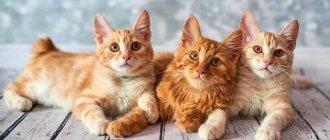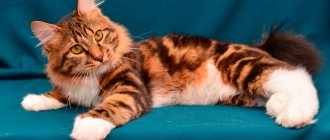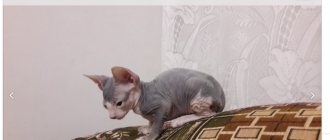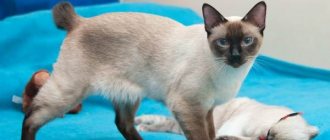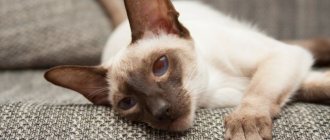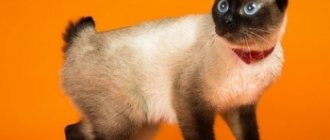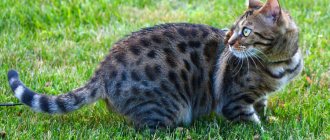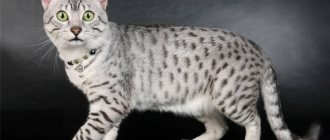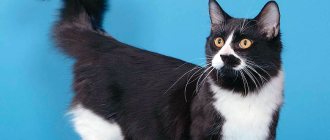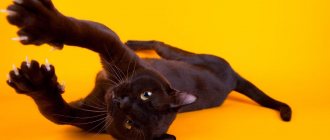Rare and exotic animals develop in conditions of geographic isolation. There are 2 subspecies of Japanese cat breeds. They are distinguished by the characteristic structure of their tail, or rather, its absence. In non-Asian countries, the breed is very rare and is distinguished by its high cost. However, for people suffering from allergies, they will become irreplaceable pets.
Common Traits of Japanese Breeds
Let's look at this in more detail. Although there are several different types of cats in Japan, they all have certain characteristics that are common to all of them. If you look closely at a photo of a Japanese Bobtail cat or any other cat, you will notice some similarities between them. This is due to the fact that representatives of all breeds are distant relatives. In addition, the following features can be distinguished between them:
- The main breed is the bobtail, and others have been developed through crossbreeding.
- The roots of the breed go back to ancient times.
- All Japanese cats have excellent health.
- Lack of abundance of colors.
- Purely Japanese breeds always have the same eye color. If you find individuals with heterochromia, then these are the creations of American breeders.
- All cats lack a tail, which is their main distinguishing feature.
If you at least once see photos of Japanese cat breeds, you will never be able to confuse them with anyone else. And, as you probably guessed, the point here is not in appearance, but in the absence of a tail. But why don't animals have it? We'll talk about this later.
Origin story
Scientists suggest that the ancestors of Japanese bobtails sailed to Japan on merchant ships from China about 1,000 years ago. In those distant times, they still had tails of standard length. The four-legged settlers lost this part of their body due to the superstitions of the local residents.
According to the official version, the animals were domesticated by Emperor Ichijo. His first pet was named Myob-no-Otodo. She was loved by the ruler and could move freely around the palace. Ordinary residents avoided long-tailed cats. They believed in the legend of a dark cat who finds unseemly people and brings misfortune to them through other cats. The Japanese sincerely believed that negative energy was concentrated in the tails of animals, so they began to shorten them.
This continued for several centuries and eventually led to mutation. Kittens with very short or crooked tails began to be born in litters. Such pets did not frighten local residents; they were believed to bring good luck. Then the doors of Japanese homes opened for tailless cats, and they became desirable pets.
At the beginning of the 17th century there was a rat infestation in Japan. Rodents destroyed food supplies and spread dangerous diseases. Then the emperor called on all residents of the country to release their pets onto the city streets so that they could help get rid of the rats. Thanks to this, bobtails were able to reproduce unhindered, their population increased greatly, and their genes were fixed. The export of cats from the country was strictly prohibited at that time.
The modern history of the Japanese Bobtail began in 1967–1968, when traders exported several individuals to Western Asia and then to America. A little later, Abyssinian cat breeder Elizabeth Freret, an American, bought 3 short-tailed pets during a visit to Japan and brought them home. The breed was standardized and registered in 1976.
The longhaired bobtail variety was only recognized in 1991. Previously, fluffy kittens were culled, but then it turned out that the Japanese emperor bred both short-haired and long-haired pets at his court. Having learned about this, the breeders insisted that felinological organizations recognize the second variety of Japanese women.
Reasons for the absence of a tail
Japan is an island nation, and its citizens' tastes are often misunderstood in other countries. This is a unique culture, strange traditions, various beliefs and much more. But why are tailless Japanese cat breeds so popular? It is impossible to answer this question, but we know how they appeared.
For a long time there was an opinion that animals had their tails cut off for a long time, and that subsequently they began to be born without it. However, such a version is unlikely. Scientists adhere to the theory that the main cause is genetic mutations. But they are not any disease or pathology, since animals, unlike many of their other brethren, have good health. Yes, cats do have a tail, but it is very small and more reminiscent of a hare’s.
Standards
| Standard | Description |
| Scull | Triangular, with clearly defined cheekbones and plump whisker pads on a funny oriental muzzle. |
| Nose | Medium length, with a pronounced “stop” on the bridge of the nose. |
| Eyes | Large, oval, wide open, set slightly askew. The color of the iris can be any. |
| Ears | Large and erect, densely pubescent on the inside. Small tassels may grow on the tips. |
| Torso | The body is long and rectangular. The muscles are visible, the general impression is that the cat is “lean”, gracefully built. The limbs are slender, long (the forelimbs are noticeably shorter than the hind limbs), arranged in the shape of the letter Z. The paws are oval and elastic. |
| Tail | Set high and curled into a ball. Its length in the straightened state is no more than 8 cm. The tails are conventionally divided into spiral and chrysanthemum-shaped. |
| Wool | The coat is thick and neat. Both short-haired and long-haired cats have very soft hair with no undercoat. In the area of the hind legs it grows thicker and more abundantly, forming lush pantaloons. |
Disqualifying signs:
- Strongly built body.
- Oval or round skull shape.
- A long tail.
- Small ears.
- Button nose.
Types of breeds
There are not too many breeds of Japanese cats, but there is still some variety. To date, breeders have developed the following:
- Irimoto.
- Snoopy.
- Bobtail.
Outside of Japan, the last two are very popular. Bobtails are even allowed at international cat shows. Let's find out how they managed to win the hearts of millions of people around the world, what they are, and whether it is worth having them in your home.
Snoopy
Despite the fact that this breed is considered Japanese, however, it has nothing to do with this country. Its historical homeland and main habitat is China, but it turned out the way it did.
The Japanese Snoopy cat breed has a unique but pretty appearance. They have very funny faces and thick cheeks. The cats are shorthaired and have a rather exotic color called “red tabby van”. The breed appeared in the middle of the 20th century thanks to American breeders by crossing Persians and American Shorthairs.
Characteristic signs
So what do you need to know about this? Representatives of this breed of Japanese cats are noticeably different from their other brothers. They are very friendly, calm and playful. Among the main characteristic external signs are the following:
- expressive brown eyes;
- small ears;
- chubby cheeks;
- very thick and soft wool;
- bushy tail.
But many breeders choose Snoopy not only for his attractiveness. These animals are phlegmatic, so they are very calm and not aggressive. In addition, they have excellent memory and well-developed intelligence.
Education and physical activity
The Japanese are smart but stubborn cats. If owners can interest their short-tailed pets in the training process, they will show impressive results.
Japanese cats are endowed with an incredibly active temperament and cannot sit for long without moving. They especially love to engage in fetching and catching imaginary flies. So that the agile and jumping Japanese can splash out their accumulated energy, they are equipped with a sports corner with ladders and multi-level platforms.
Bobtail
This breed is a subject of admiration and adoration not only among the Japanese, but also among people all over the world. In its homeland, it is considered rare and prestigious, and it is also believed that these pets bring good luck. The description of the Japanese Bobtail according to the standards is as follows:
- Slim and fit body of medium size;
- the head is shaped like a triangle with smooth curves;
- the muzzle is slightly elongated, with pronounced cheekbones;
- large and forward-leaning ears;
- oval-shaped eyes with different shades;
- long massive paws;
- short and soft wool;
- fluffy tail, the length of which can reach 15 centimeters.
If you look at the photo of the Japanese Bobtail, you will be convinced that this breed is incredibly beautiful. But appearance is not their only advantage. Animals are also distinguished by good health and unpretentiousness, so there are no special problems when caring for them.
Breed description, standards, appearance
The Japanese Bobtail is a unique cat, unlike other oriental breeds. It is easily recognized by its fluffy short tail, which resembles a shaggy pom-pom or a curled ball of fur. It is recognized by all international felinological organizations with the exception of GCCF. The CFA breed standard applies to both shorthaired and longhaired Japanese. It was last adjusted in January 2004.
Dimensions and weight
Japanese cats are medium-sized animals with moderate sexual dimorphism. Their weight varies between 2.5-4 kg.
Anatomical characteristics
A typical Japanese cat should fit the following description:
- The head is in the shape of an equilateral triangle, with high cheekbones, a long nose and pronounced whisker pads.
- The eyes are oval, slightly slanted, wide open. The Japanese Bobtail's iris can be golden, orange, brown, blue or yellow. Cats with heterochromia are especially valued.
- The ears are large, erect, slightly tilted forward. It is desirable that the inside of the shell have a good edge, and there are tassels at the tips.
- The body is slightly elongated, harmoniously built, with strong bones and clearly defined curves.
- The limbs are high, with oval paws gathered into a ball. The bobtail's hind legs are longer than the front ones, but this does not break the top line of the Japanese and provides special jumping ability.
- The tail is short and curled. The length in a straightened position does not exceed 7.6 cm. The tail of the Japanese can be curved, knotted, twisted and corkscrew-like.
On a note. Depending on the direction of the curl of the tail, Japanese bobtails are divided into “spirals” and “chrysanthemums”. In the first case, the tail has an open bend; in the second, the vertebrae are arranged in a circle and form a ring of regular shape.
Color and coat type
Depending on the length of the coat, Japanese bobtails are divided into two types:
- Short-haired. The body of such a Japanese is covered with semi-long soft hair, under which there is practically no undercoat.
- Long-haired. Bobtails of this type have silky long hair. Japanese people have shorter hair on their shoulders. The fur on the paws, tail and neck is noticeably longer.
- The Japanese Bobtail can have almost any color, with the exception of ticked tabby, lilac, chocolate and color point.
On a note. The most valuable are Japanese bobtails with mi-ke colors. This color is a combination of a white background with black and red spots.
Character and temperament
Japanese Bobtails are very peculiar cats. They become very attached to their owners and love to spend time around people. But even when alone, the Japanese will not get bored, but will find entertainment for themselves.
Bobtails are incredibly talkative and sociable creatures. The Japanese willingly “talk” to people. True, the quiet purring voice of cats is not always audible to the opponent.
Japanese Bobtails get along well with children of all ages and generously forgive them small pranks like pulling their fur.
Short-tailed cats easily get along with their brothers and friendly dogs. But the Japanese will not be able to get along with ornamental birds and rodents due to their developed hunting instinct.
Character traits
What should you pay attention to first? Japanese Bobtail cats are not like their Snoopy cousins. They are hunters by nature, so their character is simply explosive. Animals catch everything that moves, so a private house is best suited for keeping them. In a city apartment, cats will not have enough physical activity, which will negatively affect their health and behavior.
Another key point to keep in mind when owning bobtails is that they quickly learn bad habits. Therefore, upbringing needs to be done from the very first days, otherwise it will be quite difficult to retrain the cat. As for character, the animals are very friendly not only to adults and children, but also to other four-legged inhabitants. But owners will have to devote a lot of time to their pet, since bobtails are incredibly loyal and need constant communication.
Diseases
Since this is a native breed, no genetic pathologies have been identified in them. There are no claims to immunity either.
The only caveat: due to the lack of undercoat, bobtails easily catch colds. Therefore, make sure that there are no drafts in the apartment, let the cat dry thoroughly after water treatments, and also, do not allow the animal, hot after playing, to sit under the open window.
Everything else is standard. Helminths need to be driven out even if your cat does not go outside. These parasitic worms can live not only in the soil or other people's excrement, but also remain on raw meat, fish, and you can bring them into the house on your own hands or shoes. They are easy for humans to become infected with, so remember: Pirantel, Kanikvantel, Troncil K, Prazitel have proven themselves well in the pharmaceutical market. They can be given to a kitten from 3 months. A year - 4 times, if the cat stays at home, more often for street cats. After 2 weeks, cats can be vaccinated.
Expert opinion
Dusheba Vera Ivanovna
In 2010, she graduated from the Moscow State Academy of Veterinary Medicine named after K.I. Scriabin with honors, specializing in veterinary medicine. I regularly attend veterinary conferences, congresses, and webinars.
Cats nursing babies, as well as pregnant cats, should not be given medications! You should be more careful with cats that are elderly, weakened after illness, or exhausted. To be sure that you do not harm your pet, consult your doctor first. The veterinarian will examine the animal, take the necessary tests, and possibly prescribe additional tests.
Features of care
This aspect deserves special attention. As noted earlier, the Japanese Bobtail breed is unpretentious and clean. Thanks to their short fur, the animals do not shed and do not need to be brushed frequently. You also don’t have to bathe too often; once or twice a year will be enough.
But the ears should be given more attention. They need to be cleaned every week, because due to their large size, a considerable amount of dirt accumulates in them. In addition, nails should be trimmed regularly. They grow back quickly, so if they are not put in order in time, the animals will experience pain when walking.
The big problem with bobtails is curiosity. They will climb wherever possible. Therefore, you should not leave windows and doors open so that your furry friend does not run out into the street or fall off the windowsill. To distract your animal from everything dangerous and prohibited, you can purchase various cat toys and balls in the store.
As for the toilet, accustoming your pet to sand will not be difficult. Bobtails are distinguished by good intelligence, so they understand that they need to relieve themselves in the litter box, and should not shit in other places. If you live in a private house, then your four-legged friends will spend most of their time outside, where they go to the toilet. And if they feel the urge in the middle of the night, they will wake up the owner and ask to be let out into the garden.
Pros and cons of Japanese bobtails
The advantages of Japanese bobtails include the following aspects:
- These are cats with a memorable, unusual appearance. It's not just their tail that makes these cats stand out from others. They have an expressive muzzle and always an attentive, slightly wary look;
- Japanese Bobtails are loyal to their owners, so handing over an adult cat to other people is a wrong decision. The cat will really miss its previous owners.
- Bobtails are smart and have high intelligence. This allows you to train them and easily accustom them to the tray. Bobtails are sensitive to their owner’s mood and are ready to be near him at the right moment;
- Bobtails do not require careful grooming. For example, it won’t be difficult to bathe a Japanese bobtail – they are ready to get into the water themselves. The lack of undercoat makes them the least shedding cats.
The disadvantages of this breed include the following:
- The tail of Japanese bobtails really needs to be handled very carefully. Any sudden movement can cause pain and discomfort. Cats require very careful communication, so you should not touch the tail again;
- Japanese Bobtails are very active both as children and as adults. We need to buy them a lot of toys and scratching posts. Otherwise, carpets, walls and all furniture will come under attack. Also, these cats can play at night, which will prevent the owners from sleeping;
- Japanese bobtails are quite rare in the CIS countries and Europe. Kittens are extremely expensive, and finding a good nursery is difficult;
- Japanese Bobtails are stubborn. If they don’t immediately like the owner, then raising a kitten will be extremely difficult. He will do everything contrary to what the owner says;
- Bobtails are inquisitive, so they can accidentally run away from home and get lost. They also often put themselves in danger by jumping on hot surfaces or playing with sharp objects.
What to feed
So what do you need to know about this? Experts say that the diet of Japanese Bobtail cats should be of high quality and balanced. Therefore, it is better to feed not homemade food, but premium purchased dry food. If you want to start planning the menu yourself, then you need to take into account the fact that cats are carnivorous animals, so meat must be present in their life. But plant foods, which are a source of vitamins, minerals and carbohydrates, are no less important.
When feeding homemade food, it is necessary to add vitamin complexes to it. But it’s still better to stick to dry food, since they are perfectly balanced, contain all the nutrients necessary for normal growth and good health, and will also cost less than buying food in a store.
Diet
There are no special feeding requirements for Japanese Bobtails. For them, ready-made super-premium or premium food is selected; these contain only natural products and all the necessary vitamins and microelements. You can also feed with natural food; the predominance of lean meat in the diet should be in a ratio of 2:1. The main thing to remember is that a balanced diet is the key to good cat health and longevity.
Note! The Japanese Bobtail is an excellent hunter who, at the first opportunity, takes the opportunity to feast on a rodent or bird. All experienced breeders know how many deadly infections can be on the body of a stray rodent. Therefore, it is best to walk your cat on a leash. As a last resort, you can attach a collar with a bell to her neck.
Breeding
Bobtail and Snoopy cats are ready for mating at the age of one year. However, breeding them is a rather problematic activity. The thing is that these animals are not very common in our country, so finding a suitable partner for a cat in order to get purebred pedigreed kittens is not an easy task. During the search process, you need to consider the following nuances:
- presence of pedigree;
- the length of the tail should not exceed 8 centimeters;
- healthy appearance;
- activity in behavior;
- colors.
If you manage to find a suitable cat that meets all the criteria, then there will be no problems with breeding. Due to their good health, animals give birth on their own without the help of their owner. Mating is possible up to two times a year, and in one litter there can be from 2 to 7 kittens. Cats are very devoted parents, so they do not leave their children a single step, and also provide them with proper care and constant protection.
Vaccinations and antiparasitic treatment
To prevent viral and infectious diseases, the Japanese are routinely vaccinated. Cats of this breed are vaccinated with a complex drug of imported or domestic production. It stimulates the development of stable immunity to calcivirosis, rhinotracheitis and panleukopenia. The first vaccine is given to the kitten at 7-8 weeks. After 28 days he is vaccinated against the same diseases and against rabies. Subsequently, the Japanese are vaccinated annually.
To prevent the development of diseases transmitted by exo- and endoparasites, bobtails are regularly treated for fleas and helminths. Antihelminthic drugs are given to the cat twice a year with mandatory repetition after 10-14 days.
Bobtail fleas are treated with drops and shampoos. And a cat that goes on walks is additionally protected with an anti-parasitic collar.
